'People will forgive you for being wrong, but they will never forgive you for being right - especially if events prove you right while proving them wrong.' Thomas Sowell
Search This Blog
Tuesday, 27 September 2022
Thursday, 31 March 2022
Thursday, 17 March 2022
Forget ‘essential’, hijab isn’t that Islamic. Muslim women just made Western tees ‘halaal’
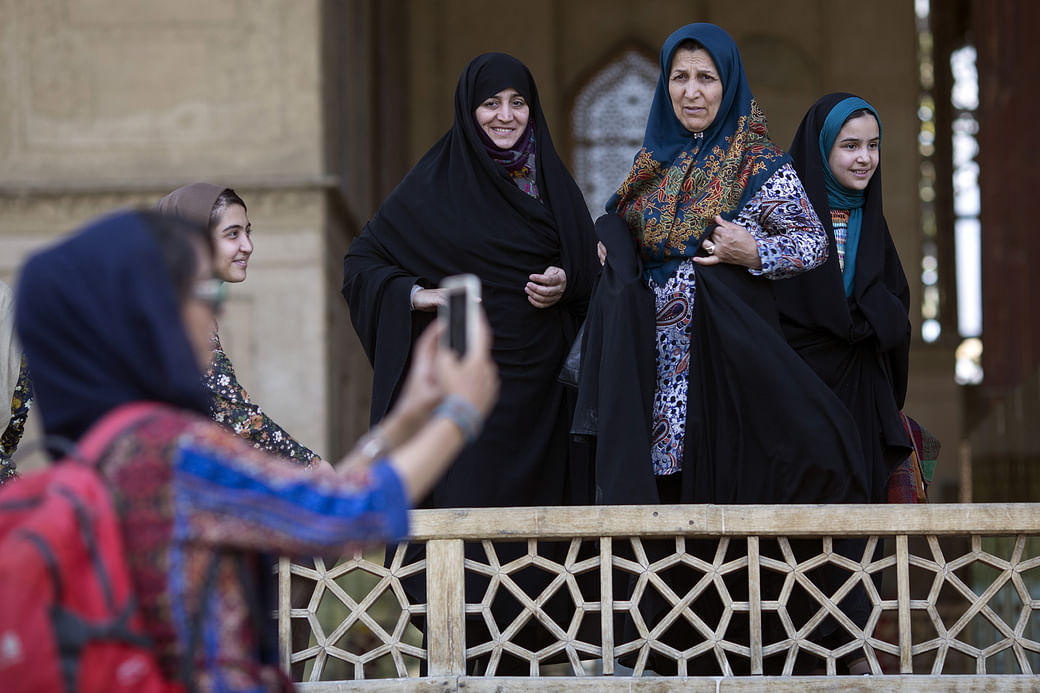
In the Arabic lexicon and the Quran, the word ‘hijab’ means a curtain, not a veil or a scarf. According to Asma Lamrabet, a Moroccan Islamic feminist, the term is reiterated seven times in the Quran, referring to the same meaning each time. “Hijab means curtain, separation, wall, and in other words, anything that hides, masks, and protects something,” she says. Never in Islamic history was this word used for a garment or a piece of clothing.
Product of new culture
The hijab, in its current form, is not older than two decades in India. As late as 2001, when this scribe stumbled upon an online matrimonial ad in which an American Muslim woman had said, “I wear hijab”, he, reasonably well-versed in Islamic idioms, couldn’t help wondering how hijab could be worn at all. He wasn’t aware that the said word had become a terminology that connoted a stylised head bandage worn to emphasise that the wearer belonged to a different religion and community and that she prided in her difference from those around her who did not belong to the same faith.
Although couched in the discourse of modesty, this was clearly a marker of identity, which soon became the uniform for religious assertion in societies where Islam wasn’t the dominant political force. The politics of this sartorial semiotics was neither lost on its proponents nor those who came to resent it.
Whether the case for hijab is argued from the vantage point of religiosity or identity, in neither case the proffered arguments could be regarded as liberal and secular. So, why can’t the liberal-secular intelligentsia tell the supporters of hijab that their insistence on displaying religious symbols in sanitised public spaces like schools is illiberal, un-secular, regressive, and militant? After all, wouldn’t it eventually harm those the most who have the greatest stake in India’s liberal secularism — the Muslim minority? Is it because the liberals, having completely lost the script and unable to fight their own battle, have been counting on the Muslim identitarian politics to keep them in the reckoning? Have they developed the same vested interest in Muslim communalism as did the British earlier?
Not a choice
Two key terminologies that have been bandied about liberally (pun intended) during the ongoing controversy — one in affirmation and the other in negation — are ‘choice’ and ‘patriarchy’. It has been argued that wearing any dress is a matter of individual choice. Of course, it is. However, one might ask whether the votaries of the hijab concede this right to all women to wear any dress of their choice. Would the very girls who have been exercising their “individual choice” to wear the hijab to school be able to walk freely, if they so chose, without it through their Muslim neighbourhoods and not compromise their families’ honour or invite opprobrium on themselves?
Hijab is not an individual choice, it’s a communal compulsion.
The pace at which it has been spreading hints that the day is not far when Muslim women not conforming to it may no longer be recognised as Muslims. This is what was going to happen if the Karnataka High Court’s judgement had gone the other way.
Equally insidious has been the narrative that the assertive display of the hijab is a setback to Islamic patriarchy. Far from it. Both in form and content, and very consciously too, this trend signifies the revival of orthodoxy, including its patriarchal presumptions. The religious sanction for man’s supremacy and his right to decide for women is not being questioned. Instead, what rankles is the loss of political supremacy of the supposed Muslim community. Muslim women, too, are supposed to have suffered from this loss.
Therefore, they, instead of seeking equality with men, are engaged in the higher pursuit of reviving supremacy over other religions. Their gender is not only secondary to Islam, but, as seen in the use of the hijab as a tool of religious assertion, also deployed in service of the religion. The capability and agency gained as blessings of education and modernity are ploughed back into the religious-political discourse.
Towards communal visibility
Another myth being circulated is that the hijab is an enabler for education, which is to say that had it not been for the hijab, Muslim girls wouldn’t be able to go out for studies. The fact, however, is that till the very end of the 20th century — before it became a common sight — most Muslim girls attended schools and colleges dressed in the same attire as other girls. The same trend would have continued if religious radicalisation had not permeated the socio-political atmosphere.
Therefore, before educating Muslim women on the hijab, so that a case could be made for the latter’s essentiality, our liberal-secular intelligentsia should have done better to wonder why an outer covering over the regular dress, which was not considered necessary earlier, became a precondition for going for studies.
This is despite the fact that the nature of the Muslim woman’s modest dressing underwent a change through the years. Before the head-wrap became trendy wear, there were three moot questions — Should a Muslim woman freely go out of her house? Should her face be covered with the naqaab? Can she, like men at home, wear Western attire?
The new hijab took care of all the questions. Women could go out. The face was exposed, but instead, the head and the neck had to be covered in a particular style, and, if topped with the hijab, Western dresses such as jeans and tee shirts became halaal.
Hijab replaced the earlier invisibility of the Muslim woman with a hypervisibility of her religious identity. Whether this identity should compulsively be asserted in public spaces is the question that Indian Muslims need to resolve wisely.
Friday, 18 February 2022
Thursday, 17 February 2022
Wednesday, 16 February 2022
Monday, 14 February 2022
Sunday, 13 February 2022
Saturday, 12 February 2022
Muslim women must see burqa is just like chastity belt of dark ages, Taslima Nasreen writes
Taslima Nasreen in The Print
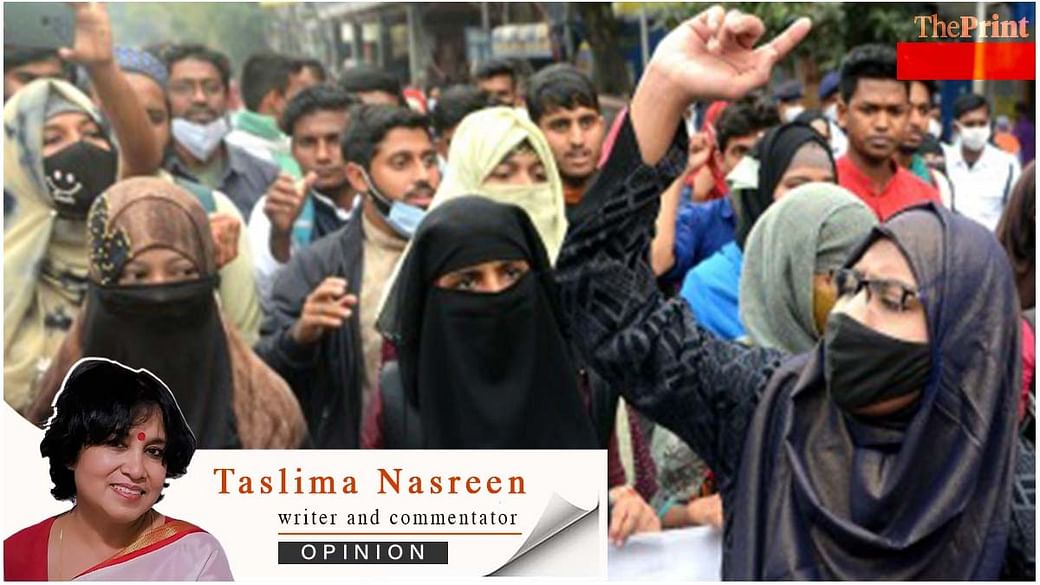
There is practically no difference between a Jewish, Christian, Muslim or Hindu fundamentalist. They are all primarily ‘intolerant’. Standing next to the mortal remains of playback singer Lata Mangeshkar, Muslims have prayed to Allah, Hindus to Bhagwan, and Christians to their almighty God. Seeing Bollywood icon Shah Rukh Khan lifting his hands in prayer and blowing on her body, some Hindu extremists thought that he was spitting. Then social media mayhem descended.
I have noticed that in India, while Muslims are largely aware of Hindu rituals and practices, most Hindus are ignorant about Muslims ones. Similarly in Bangladesh, Hindus understand Muslim rituals more than what Muslims know of Hindus.
To a large extent, intolerance stems from ignorance. As we saw in the Shah Rukh Khan incident, people from all religions stood behind him. In fact, there are enough liberal and rational people in the Hindu community to oppose the extremists.
The row over hijab
An unnecessary controversy over hijab has erupted in another part of the country, Karnataka. After authorities raised objection to female students from wearing hijab to colleges, the protest by Muslim students started. Then, a group of students donning saffron scarves, took to the streets protesting against the burqa. Chief Minister Basavaraj Bommai ordered schools and colleges to remain shut for a few days. But this is not a solution. If the state fears riots, then violence can erupt when schools and colleges reopen. To prevent riots, the mindset needs to change, and hatred and fear for each other need to be washed clean. In this regard, the Karnataka High Court’s interim order makes sense. I believe, uniform civil code and uniform dress code are necessary to stop conflicts. Right to religion is not above the right to education.
The distance between Hindus and Muslims has not been bridged even after 75 years of Partition. Pakistan has separated from India and has turned into a religious state. But India never wanted to become a Pakistan. Or it could have easily turned into a Hindu State 75 years ago. The Indian Constitution upholds secularism, not religion. This country, with a majority Hindu population, is home to the second largest Muslim population in the world. The laws of India give equal rights to people from all religions, castes, languages, creeds, and cultures.
It is perfectly all right for an educational institution in a secular country to mandate secular dress codes for its students. There is nothing wrong in such a message from the school/college authority that states that religion is to be practised within the confines of the home. Educational institutions, meant for fostering knowledge, are not influenced by religion or gender. It is education that can lift people from the abyss of bigotry, baseness, conservativeness and superstitions into a world where the principles of individual freedom, free-thinking, humanism and rationality based on science is valued highly.
In that world, women do not feel pride in their shackles of subjugation but rather break free from them, they do not perceive covering themselves in a burqa as a matter of right but as a symbol of female persecution and cast them away. Burqas, niqabs, hijabs have a singular aim of commodifying women as sex objects. The fact that women need to hide themselves from men who sexually salivate at the sight of women is not an honourable thought for both women and men.
Education is supreme
Twelve years ago, a local newspaper in Karnataka published an article of mine on burqa. Some Muslim fundamentalists vandalised the office and burnt it down. They also burnt down shops and businesses around it. Hindus also hit the streets in protest. Two people died when the police opened fire. A simple burqa can still cause fire to burn in this state. Riots can still break out over burqas.
A burqa and hijab can never be a woman’s choice. They have to be worn only when choices are taken away. Just like political Islam, burqa/hijab is also political today. Members of the family force the woman to wear the burqa/hijab. It is a result of sustained brainwashing from a tender age. Religious apparel like the burqa/hijab can never be a person’s identity, which is created by capabilities and accomplishments. Iran made hijab compulsory for women. Women stood on the streets and threw away their hijabs in protest. The women of Karnataka, who still consider hijab as their identity, need to strive harder to find a more meaningful and respectable identity for themselves.
When a woman’s right to education is violated on the pretext of her wearing a hijab, when someone forces a woman out of hijab as a precondition to education, I stand in favour of education even in hijab. At the same time, when a woman is forced to wear a hijab, I stand in favour of throwing the hijab away. Personally I am against hijab and burqa. I believe it is a patriarchal conspiracy that forces women into wearing burqa. These pieces of clothing are symbols of oppression and insult to women. I hope women soon realise that burqa is not different from the chastity belt of the dark ages that was used to lock in women’s sexual organs. If chastity belts are humiliating, why not burqa?
Some say that the furore over the burqa in Karnataka is not spontaneous and is supported by political forces. This sounds very familiar to saying that riots do not happen, but are manufactured — mostly before elections and almost always between Hindus and Muslims. Apparently they do count for a few votes. I, too, was thrown out of West Bengal for a few votes.
It is heartening that riots do not happen. It would be frightening if they did happen spontaneously. Then we would have surmised that Hindus and Muslims are born enemies and can never live with each other peacefully.
I believe that even the Partition riots didn’t happen on their own but were made to happen.
A new India
I have heard some Hindu fanatics call for India to be turned into a Hindu Rashtra, where non-Hindus will be converted to Hinduism or be forced to leave the country.
I really do not know if such people are big in numbers. I know India as a secular state and love it that way. I have confidence in the country. Is India changing? Will it change? I am aware of the liberality of Hinduism as a religion. One is free to follow or not follow it. Unlike in Islam, Hinduism does not force one to follow its practices. Hinduism doesn’t prescribe people to torture, imprison, behead, hack or hang someone to death for blasphemy. Superstitions still exist in Hinduism, even though a lot has waned with time. But, India will be a country only for Hindus, anyone criticising Hindus or Hindutva will be killed — are statements that are new to me.
I have been critically scrutinising all religions and religious fundamentalism in order to uphold women’s rights and equality for more than three decades now. My writings on Hinduism and religious superstitions suppressing women’s rights have been published in Indian newspapers/magazines and have also been appreciated. But today, as soon as I pose a question like, “Why do men not observe Karva Chauth for the welfare of women?” hundreds of Hindus hurl personal attacks and abuse on me demanding my expulsion from the country. This is a new India. An India that I cannot imagine. I find their behaviour similar to Muslim fundamentalists. Utterly intolerant.
If India was a Hindu Rashtra, will all fundamentalists and liberal Hindus be able to live peacefully? Will there be no discontent among the dominant and oppressed castes, no discrimination between men and women? A state only for Hindus? Perhaps. Just the way Jews have carved a state for themselves, and Muslims have Pakistan.
I will have to leave a Hindu Rashtra too because I cannot become a Hindu. I am an atheist and a humanist, and I choose to stay that way. Gauri Lankesh, I believe, was a humanist. She was not fit for a Hindu Rashtra, nor will I be.
Friday, 11 February 2022
"The Inside Story on The Hijab - School case"
Anusha Ravi Sood in The Print
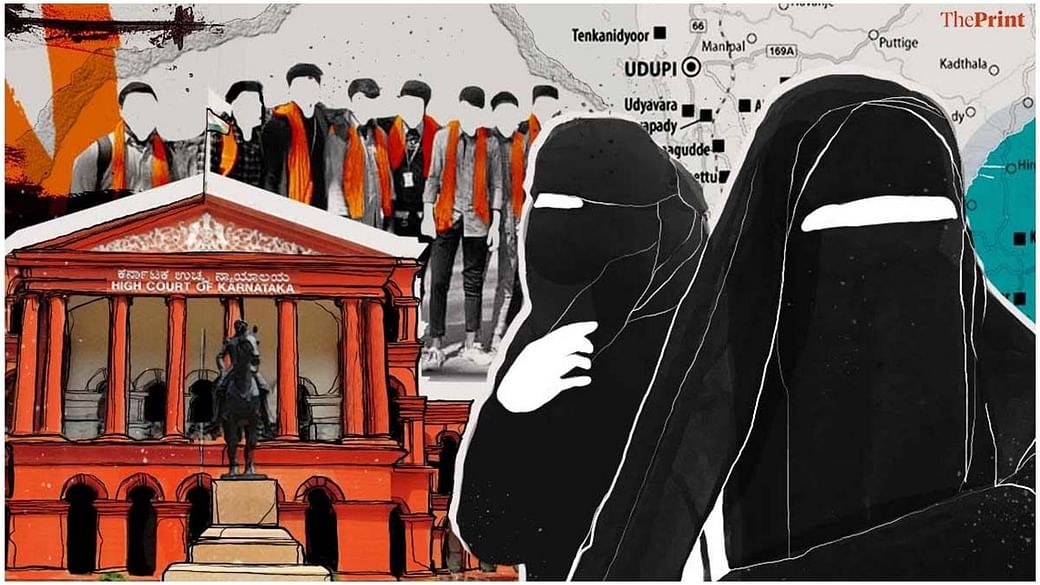
Udupi: Abdul Shukur took a sip of water and bit into a chikki (peanut bar) at 6:30pm Tuesday. It was his first meal after a day-long fast and he had come to offer prayers at the Jamia Masjid in Udupi, Karnataka. Shukur’s daughter, Muskaan Zainab, studies at the city’s Government Pre-University (PU) College and is one of several students who have petitioned the Karnataka High Court for the right to wear the hijab (headscarf) on campus.
“Our entire family fasted today since our petition was being heard in court. I will fast tomorrow too,” 46-year old Shukur, who runs a small business in Malpe, said.
The hijab row has been making headlines since January, but Shukur claimed the issue was triggered in October when viral photos showed Muslim girls at a protest organised by the Akhil Bharatiya Vidyarthi Parishad (ABVP, the RSS-affiliated students’ body).
The images in question were posted on the Facebook page of the Udupi ABVP on 30 October last year. They showed Muslim girls holding the ABVP flag as part of a protest demanding a probe into the alleged rape of a Manipal student. In the communally sensitive coastal belt of Karnataka, the pictures ignited a controversy.
“I was taken aback to see my daughter there… because she isn’t a member of ABVP,” Shukur said. Furthermore, Muskaan was not wearing her usual headscarf in the photo.
“I asked her why she wasn’t wearing a headscarf in the photo, and that is when she told me that the college doesn’t allow hijabs in classrooms,” he said. This came as a shock to Shukur, who decided to confront the college principal.
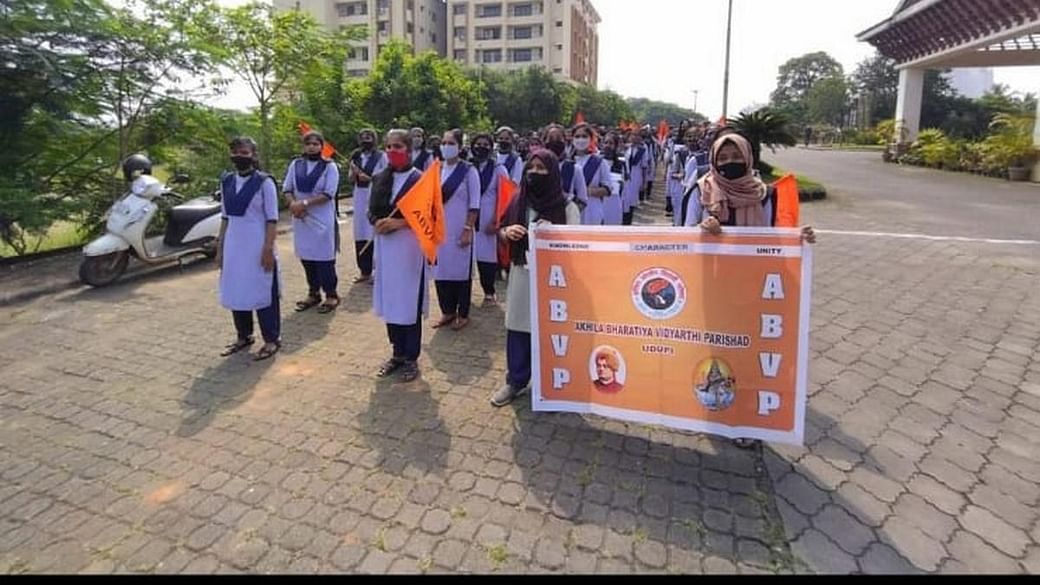
He was not the only one taking notice. According to an intel report submitted by the Udupi police to the state government, the Campus Front of India (CFI), which is the students’ wing of the Islamist outfit Popular Front of India (PFI), had approached parents with the offer to help take on the college management.
A source from the CFI who did not wish to be named told ThePrint that the ABVP protest incident had outraged the organisation. It therefore started encouraging Muslim women to refuse to join ABVP events and to fight for their right to wear hijabs in the classroom. The women’s parents also took these demands to the college.
“When I asked the principal why students were being sent to protest without consent and were not allowed to wear headscarves, he said it was a small issue,” Shukur said.
Rudre Gowda, principal of the college, rejected this allegation. “For years, students have been wearing hijabs to campus, but have been removing them during classes. These girls too were adhering to this, but since December, they started demanding that hijab should be allowed during classes too,” Gowda told ThePrint.
The matter quickly led to a standoff between the families of six Muslim students and the college management. The CFI also alleged that the college had, as retaliation, made details of the girls and their families public.
While there were attempts to negotiate an understanding between the students and the college authorities in Udupi, the row escalated rapidly — partly due to political organisations jumping on to the bandwagon and partly due to the wildfire effect of social media.
In January, the students petitioned the Karnataka High Court, by which time the issue was making headlines and had snowballed into communally charged conflicts in several Karnataka colleges.
Also Read: A timeline of how hijab row took centre stage in Karnataka politics and reached HC
Bruised egos and social media hype

Before the hijab issue reached the headlines, there were weeks of efforts to forge an understanding between the families and the college.
A senior leader of the Udupi District Muslim Okkoota — an umbrella organisation of mosques, jamaats, and Islamic organisations in Udupi — told ThePrint on the condition of anonymity that the body had tried its best to convince the families that it was acceptable to remove the hijab in class.
“We advised the girls to not make a big issue out of not wearing hijab inside classrooms. We even took them and their parents to religious clerics and explained that it was okay to remove hijabs in the classroom,” he said.
However, the students were “adamant”, he said, because they had received backing from the CFI, the campus affiliate of the PFI, an Islamist outfit that was set up in Kerala in 2006 and which the Bharatiya Janata Party (BJP) wants banned because of its allegedly radical tendencies.
“The CFI saw [the hijab conflict] as an opportunity to strengthen its support base,” the Muslim Okkoota leader said. In coastal Karnataka, he explained, the two main students’ bodies are the ABVP and CFI, while the Congress’s campus body, the National Students Union of India (NSUI), does not have a presence in local colleges.
When ThePrint spoke to CFI members in Udupi, they claimed that the organisation got involved only after students of the PU College approached them on 27 December, after their memorandums to the district commissioner and education department officials did not yield results. The students in question also told ThePrint that they were not members of the CFI. However, at least three parents are members of the PFI’s political wing, the Social Democratic Party of India (SDPI).
By the end of December, though, nobody was in the mood for a compromise, according to the Muslim Okkoota leader. He said that the Muslim women’s protest, and the social media traction it got, riled the College Development Committee (CDC), which is empowered by the government to take administrative decisions for public educational institutions.
“In December and January, the students’ protests started getting attention on social media and the press. They were shown standing outside the classroom and making notes since they were not allowed inside. This hurt the egos of the committee members,” he claimed, adding that the senior-most members of this body were members of the BJP and RSS. None of the 21 members in the CDC are from the Muslim community.
The matter had now become a “prestige issue” with the BJP and other Hindutva organisations on one side, and the PFI and its affiliates on the other, the Muslim Okkoota leader said.
BJP vs. PFI
What both Hindutva and Muslim organisations can agree on is that as videos from Udupi went viral, they sparked protests in other districts too. Throughout January and February, Karnataka saw several face-offs in colleges between some students in hijabs and others wielding saffron scarves. Each side holds the other responsible.
BJP leaders maintain that without “instigation” from the PFI, the protests wouldn’t have reached such a magnitude.
“Within two days of the girls’ protest in January outside their classrooms, thousands of social media posts were released. How is that possible without a pre-planned, strategised effort?” V. Sunil Kumar, Minister for Energy and Kannada & Culture, told ThePrint.
“When [Muslim students] started escalating the matter, naturally, students from the Hindu community retaliated — a matter of action and reaction,” Kumar, who is also the MLA from Karkala in Udupi district, added.
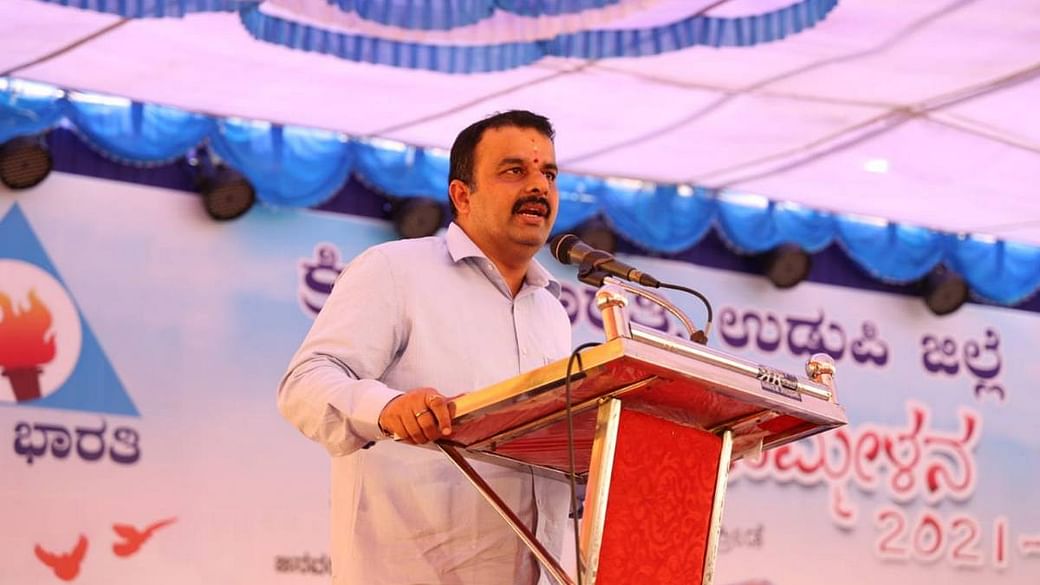
Other BJP ministers in the Basavaraj Bommai cabinet have also made similar allegations against the PFI. “Students are being instigated to protest for hijab. The role of the PFI and its student wing CFI will be probed thoroughly,” B.C. Nagesh, Karnataka Minister of Primary & Secondary Education, told reporters Tuesday.
The PFI has denied such allegations and has attempted to distance itself from the row.
“As an organisation, we are working for upliftment of marginalised communities. We are in no way involved in this row. Our student wing (CFI) is only trying to provide moral support to aggrieved students. Communal flareups only benefit the BJP,” Anis Ahmed, national general secretary of the PFI, told ThePrint.
The CFI has acknowledged that it was helping the Muslim women’s agitation in Udupi’s PU College, but denied having any political motives.
“We are a student organisation. We do not have any links with political parties. We are leading the students who are fighting for their rights. Muslim students have been harassed at that institute for years now. This is not a retort that erupted overnight,” Masood Manna, a committee member of CFI Udupi, told ThePrint.
Also Read: The right answer to the wrong hijab question is still a wrong answer
Why the PFI and its affiliates are so controversial
The PFI is the organisational successor of the Kerala-based National Development Front (NDF) and claims to fight for social justice for Muslims, particularly in the southern states of Kerala, Karnataka, and Tamil Nadu.
In 2010, the political wing of the PFI — the Social Democratic Party of India (SDPI) — was registered with the Election Commission. Since then, it has slowly been making inroads in the coastal Karnataka belt. It had one of its biggest triumphs in the December 2021 elections to 58 Urban Local Bodies (ULBs) in Karnataka, when it won six seats.
The CFI, meanwhile, is popular among Muslim students in three districts of coastal Karnataka — Udupi, Dakshin Kannada and Uttar Kannada. The CFI has actively eaten into the popularity of the Congress’s student wing, the NSUI, in the three districts.
However, the PFI has faced allegations of radicalism from the BJP. In April last year, the Union government told the Supreme Court that it was in the process of banning the PFI, claiming that many office-bearers had links with the now banned Student Islamic Movement of India (SIMI). Chargesheets have also been filed against members of PFI over their alleged involvement in various instances of unrest, which the organisation has dismisses as “baseless”.
Notably, some Muslim community leaders also have reservations about the PFI and its branches. The senior Muslim Okkoota leader who was quoted earlier alleged that the hijab protests seemed to be a ploy by the organisation’s political wing to mobilise support.
“All the Muslim girls use the same vocabulary… ‘fundamental rights’, ‘constitutional issue’, ‘hijab is intrinsic to Islam’. While they may have been wearing hijab for years, the words and phrases that are being publicly said are coming from one source,” the Muslim Okkuta leader claimed.
Allegations of “instigation”, however, have also been levelled against Hindutva organisations, which have started a counter-agitation involving saffron shawls and scarves, and an influx into colleges of ‘protesters’ who are not even students.
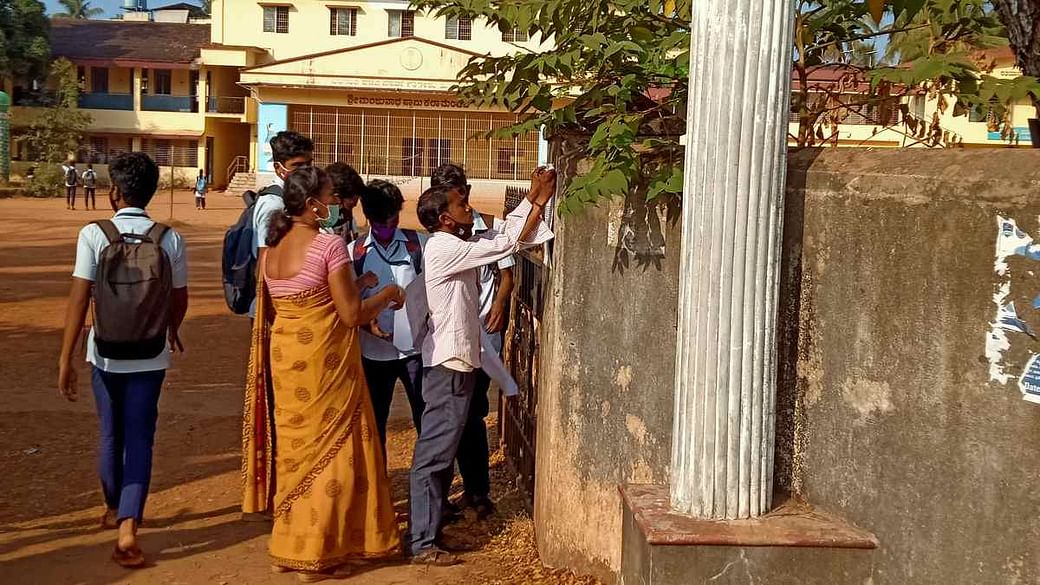
Doubling down on the hijab
“Perhaps one or two Muslim girls used to wear hijab to college but now the number has drastically increased. They are doing this to assert their religious identity,” Halady Srinivas Poojari, MLA for Kundapur, told ThePrint. He isn’t far off the mark, although there are varying interpretations of why exactly the women are doing so.
According to Abdul Aziz Udyavar, organising secretary of the Udupi District Muslim Okkoota, the fight over the right to wear the hijab has inspired other girls from the community to exercise their constitutionally guaranteed freedoms. “Just because I was not exercising my right before doesn’t mean I shouldn’t do it in the future,” Udyavar said.
Principals of at least three colleges in Kundapur told ThePrint that while some Muslim students had always worn the hijab to classes, the number had increased ever since the row took off in January.
“There is no explicit rule that bans hijab in the college, but there is no rule that permits it either,” Naveen Shetty, principal of R.N. Shetty College, said.
According to him, students who sought permission to wear hijabs earlier could usually do so “as long as it doesn’t cause trouble”. Now, Shetty said, it was causing trouble and so hijabs as well as saffron scarves were banned in the college. “The management decided to ban both explicitly until the time the high court order comes,” Shetty added.
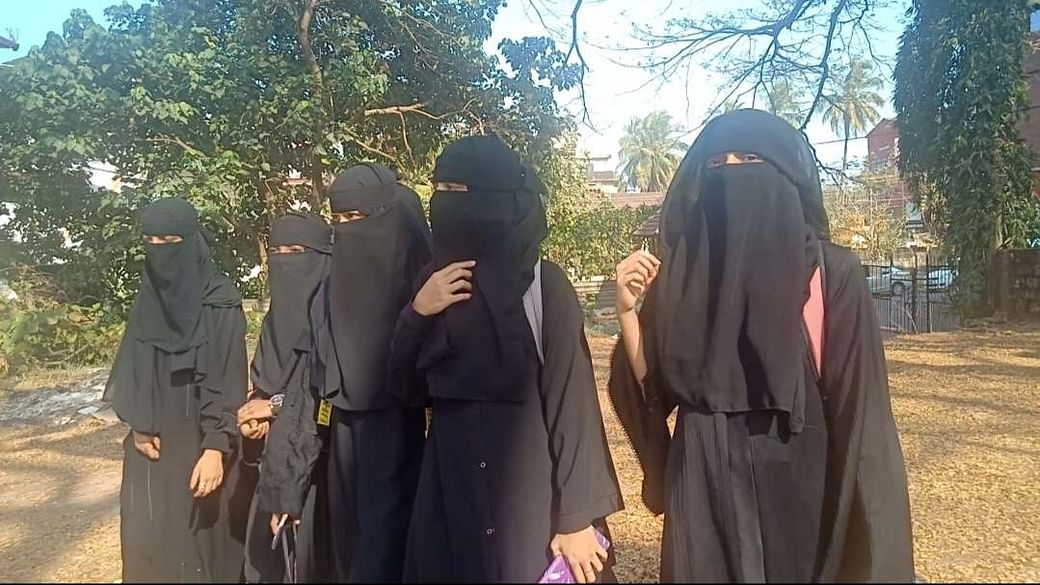
The Udupi PU College students who petitioned the court told ThePrint that they shouldn’t have to choose between their education and wearing a hijab, but said their stance has come at a cost to them.
Abdul Shukur, Muskaan’s father, said he was concerned for the family’s safety. Another student, A.H. Almas, told ThePrint about the hostility that she was encountering.
“When we started protesting, our details were leaked and unknown people follow us around,” she alleged, adding that members of the CFI were giving the women protection.
The Muslim Okkoota had until recently refrained from openly backing the hijab cause but has now reconsidered its decision. “When Muslim girls who are studying at co-ed colleges that have allowed hijab for years started getting targeted, we had to step in since it is injustice being meted out to them,” Ibrahim Sahib Kota, president of the Udupi Muslim Okkoota, said.
‘Senior VHP, Bajrang Dal, Hindu Jagaran Vedike leaders oversee saffron scarf distribution’
When ThePrint visited Mahatma Gandhi Memorial (MGM) College in Udupi, students wearing hijabs were engaged in a face-off with others who had donned saffron scarves and headgear. But, when ThePrint spoke to many of the Hindu protestors, they admitted they were no longer students of the college.
“I studied commerce here and passed out in the 2016-2017 academic year,” Sushanth sheepishly told ThePrint, identifying himself as an ABVP member. “For many years, [Muslim women students] have been wearing hijabs in classrooms but now since they are making a strong assertion of their religious right, should we not as Hindus assert our religious identity too?” he asked, insisting that the protesting Hindu students had all brought their own saffron scarves and shawls.
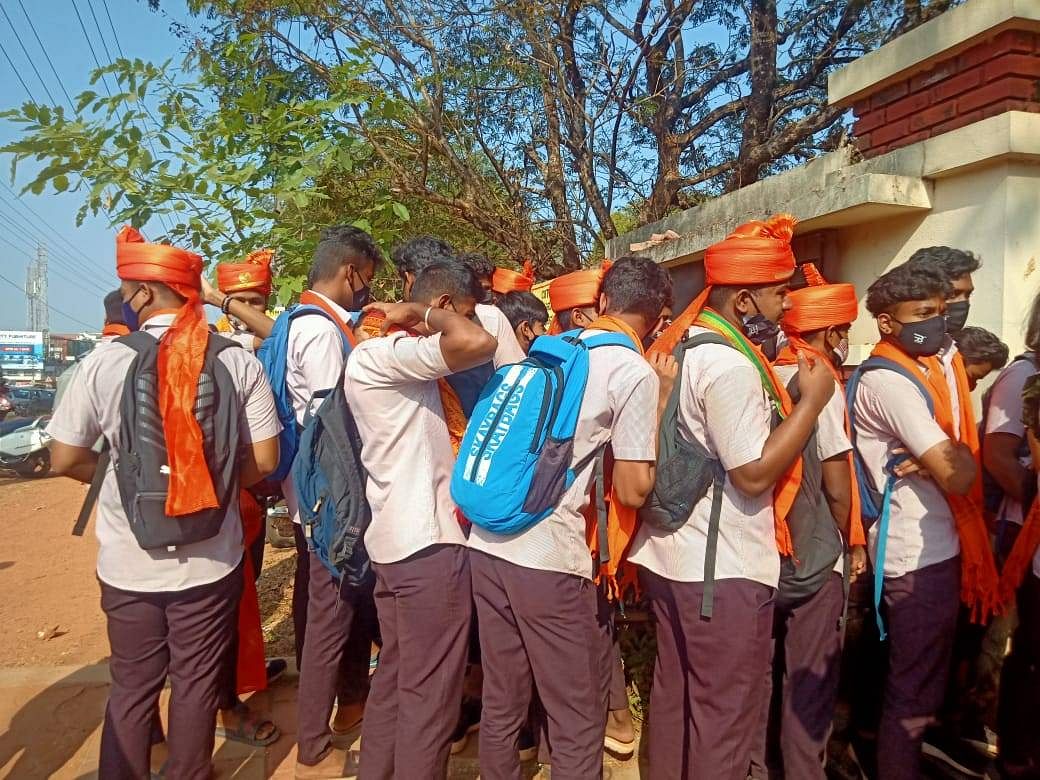
ThePrint, however, witnessed male protestors distributing saffron shawls to women students who had just arrived at the college. The scene was in line with a couple of videos that went viral this month: One showed students returning their saffron headgear to purported members of the Hindu Jagaran Vedike near their college, and another showed someone in an Innova car distributing saffron scarves to students at a college in Kodagu.
Another protestor, Akshat Pai, said he had graduated from the college in 2014, but was there in his capacity as a Hindu Jagaran Vedike leader. “We haven’t pressured the students into protesting. They are doing it on their own,” Akshat Pai said, as students in saffron accessories hovered around him and asked whether they should leave or stay.
A first-year B.Com. student, a Hindu woman, told ThePrint on the condition of anonymity that many of the protestors did not study at the college. “Why are outsiders coming and supplying saffron scarves to our collegemates?” she asked, adding that she had no problem with the hijab just as her Muslim friends had no objection to the bindi on her forehead.
Harshita, another Hindu student at MGM college, had a different viewpoint. She cited a 5 February government order proscribing clothes that “disturb public law and order” and said that if Muslim women could wear hijabs, Hindus could wear saffron scarves.
Prakash Kukkehalli, Mangaluru unit general secretary of the Hindu Jagaran Vedike, was observing the protest at MGM college from the other side of the road, with young men from the campus occasionally arriving to consult with him.
“We are not instigating students. We are only giving them moral support,” Kukkehalli told ThePrint.
According to him, the PFI, SDPI, and other Muslim organisations were provoking students for political benefit. “They have launched social media warfare to dent the image of India,” he said. “Today they will ask for hijab, tomorrow it will be Sharia law… a separate nation.”
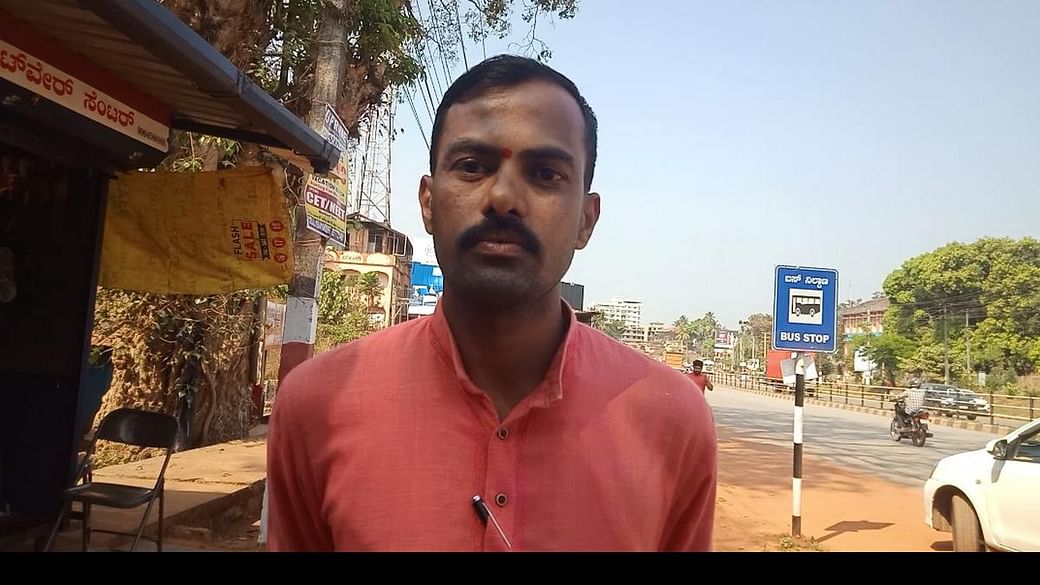
A former ABVP office-bearer, who did not want to be named, told ThePrint how the saffron scarf protest is orchestrated by Hindutva organisations.
“The saffron scarves are procured and distributed by office bearers. Senior leaders of the VHP, Bajrang Dal, Hindu Jagarana Vedike even visit protest sites to observe whom to groom as a leader and if anyone is straying away from discussed slogans or statements,” he said.
This former ABVP leader added that he did not believe in this kind of “communal activism”, whether from Hindus or Muslims, since it only harmed students’ prospects.
“Student activists should be fighting for better colleges, professional courses and employment — not this hijab or saffron scarf fight,” he said.
A deputy superintendent-rank police officer from Udupi told ThePrint that the police were aware of saffron scarves being handed out to students, but that this was not a crime. “Just before students arrive at their colleges, saffron scarves are being handed to them but that is not an offence,” the police officer said.
Over the past few days, though, the protests have taken a more violent turn. The police arrested 15 people in Shivamogga and Bagalkot districts Tuesday. Last week, police in Kundapur, Udupi, arrested two people, Abdul Majeed and Rajab, who were carrying knives near Kundapur Government PU College.
Communally sensitive belt of Karnataka
The three districts of coastal Karnataka — Dakshin Kannada, Uttar Kannada, and Udupi —are often counted among the more communally sensitive regions in India. All three districts have a sizeable population of Muslims as well as Christians.
“There are at least a hundred communal violence incidents in Udupi and Dakshin Kannada alone annually,” Suresh Bhat Bakrabail, an activist of the Karnataka Communal Harmony Forum (which keeps a track of communal violence incidents in coastal Karnataka) told ThePrint. In 2021, in a four-year high, there were more than 120 such incidents in these two districts alone.
Social activists attribute the frequent communal flare-ups in the region, which is frequently described as a “Hindutva laboratory“, largely to incitement from radical Hindu and Muslim organisations.
Thursday, 10 February 2022
Monday, 7 February 2022
Sunday, 15 January 2017
Wednesday, 8 April 2015
Is the Veil (Burqa/Hijab) a sign of Islamic fundamentalism?
As a Muslim woman, I see the veil as a rejection of progressive values
------
BBC Documentary 2015 - This World - Britain's Jihadi Brides
Saturday, 21 March 2015
As a Muslim woman, I see the veil as a rejection of progressive values
Yasmin Alibhai Brown in The Guardian

It could be a millenarian crisis or a delayed reaction to decades of bad history, but millions of Muslims seem to have turned inwards, hankering for an imagined golden age. They are contemptuous of modernity’s bendable, ductile values. Some are drawn to reactionary dogma, and preachers while a good number have thrown themselves into political Islam to resist and combat western hegemonies – or so the story goes.
As a practising (though flawed) Shia Muslim, I watch the new puritans with apprehension. So too other Muslims worldwide, the silent many, watch and tremble. From the eighth to the early 20th century, Muslims strove for a broad education (as commanded in the Qur’an), questioned doctrines, and were passionate about scientific advancements, political and social ideals and art. Not even humiliating colonial rule deterred them from the march forward. Now the marchers are walking backwards. The hijab, jilbab, burqa and niqab are visible signs of this retreat from progressive values.
This article will divide people. Women I respect and like wear hijabs and jilbabs to articulate their faith and identity. Others do so to follow their dreams, to go into higher education or jobs. And an increasing number are making a political statement. I am not assuming that the coverings all represent simple oppression. What I am saying is that many women who take up the veil, in any of its forms, do so without delving fully into its implications, significance or history. Their choice, even if independently made, may not be fully examined.
Muslim feminists of the past critiqued and repudiated the veil. One of them was a man, Qasim Amin, an Egyptian judge and philosopher, who in 1899 wrote The Liberation of Women.He was the John Stuart Mill of the Arab world. Huda Shaarawi set up the Egyptian women’s union in the early 1920s. One day in 1923, as she disembarked from a train in Cairo, she threw off her veil and claimed her right to be visible. Educated Iranian women started feminist magazines and campaigned against the veil around the same time. These pioneers have been written out of history or are dismissed as western stooges by some contemporary Muslim intellectuals.
After the transformative 60s, Muslim feminists resumed the fight for equality. European rule was over. It was time. The Moroccan academic Fatema Mernissi, Egypt’s Nawal El Saadawi and the Pakistani scholar Riffat Hassan all argued for female emancipation. They rightly saw the veil as a a tool and symbol of oppression and subservience. Mernissi’s Beyond the Veil ( 1975) is a classic text. So too El Saadawi’s The Hidden Face of Eve (1975). But more conservative Islamic tenets have taken over lands, communities, families, heads and hearts.
The promise of this version is a return to certainties and “purity” of belief, a mission backed by Saudi Arabia and other Gulf states. Deobandi revivalists, funded by Arab money, now run more mosques in Britain than any other Muslim subgroup. Women are told not to travel without male relatives, not to work, to be subservient, to veil. This movement began as a reaction against the Indian raj and mutated into a fundamentalist creed. Today their pushback against “cultural imperialism” appeals to many alienated young Muslims. And, in part, it explains the growing popularity of the hijab, jilbab and full veil .
But in the Qur’an, the veil is mostly used metaphorically to describe barriers between good and bad, believers and nonbelievers. In two verses, women are told to lower their gaze, and to cover their private parts and bosoms. Men are also instructed to lower their gaze, and to dress modestly. One verse commands the women in the prophet’s family to fully veil, partly to protect them from enemies and supplicants.
Sahar Amer, associate professor at the University of North Carolina, has studied these sacred injunctions: “[Nowhere] is the hijab used to describe, let alone prescribe, the necessity for Muslim women to wear a headscarf or any other pieces of clothing often seen covering women in Islamic countries today. Even after reading those passages dealing with the female dress code, one continues to wonder what exactly the hijab is: is it a simple scarf? A purdah? A chador? Or something else? Which parts of the body exactly is it supposed to cover? Just the hair? The hair and neck? The arms? Hands? Feet? Face? Eyes?”
Veils, in truth, predate Islam. Zoroastrian and Byzantine upper-class ladies wore them to keep aloof from the hoi polloi. When Islam’s armies first reached Persia, they were shocked at this snobbery; then they adopted the custom they loathed; the control of women was hard-wired into their psyches.
All religions cast women as sinners and temptresses. Conservative Islam has revived the slander for our times. Women have to be sequestered or contained lest they raise male lust and cause public disorder. Some young Muslim women argue that veils liberate them from a modern culture that objectifies and sexualises females. That argument is appealing; but if credible, why would so many hijabis dress in tight jeans and clinging tops, and why would so many Muslim women flock to have liposuction or breast enhancements?
It is complicated: veils for me represent both religious arrogance and subjugation; they both desexualise and fervidly sexualise. Women are primarily seen as sexual creatures whose hair and bodies incite desire and disorder in the public space. The claim that veils protect women from lasciviousness and disrespect carries an element of self-deception. I have been at graduation ceremonies where shrouded female students have refused to shake the hand of the chancellor. Veiled women have provoked confrontations over their right to wear veils, in courts, at schools and in colleges and workplaces. But I regard their victories as a rejection of social compromise.
Of even more concern are young Muslim lives. Little girls are being asked to don hijabs and jilbabs, turned into sexual beings long before puberty. You can even buy stretchy baby hijabs with fake Calvin Klein and Versace logos.
Like a half-naked woman, a veiled female to me represents an affront to female dignity, autonomy and potential. Both are marionettes, and have internalised messages about femaleness. A woman in a full black cloak, her face and eyes masked walked near to where I was sitting in a park recently, but we could not speak. Behind fabric, she was more unapproachable than a fort. She had a baby girl in a pushchair. Her young son was running around. Will the girl be put into a hijab, then a jilbab? Will the son expect that of his sister and wife one day? To never have the sun warm your face, the breeze through your hair – is that what God wants? Whatever happened to sisterhood?
But do those who choose to veil think of women in Iran, Saudi Arabia, Afghanistan, Pakistan, Iraq, and even the west, who are prosecuted, flogged, tortured or killed for not complying? This is not a freestanding choice – it can’t be. Although we hear from vocal British hijabis and niqabis, those who are forced cannot speak out. A fully burqaed woman once turned up at my house, a graduate, covered in cuts, burns, bruises and bites. Do we know how many wounded, veiled women walk around hidden among us? Sexual violence in Saudi Arabia and Iran is appallingly high, as is body dysmorphia.
Liberalism is being tested by the new Islamic ardency. A French-style ban would be unwise and unjust. But institutions can apply dress codes. A bank worker cannot dress like a stripper; a child cannot wear a boob tube to school. Have rules and stick to them, within reason. In 1899, Qasim Amin warned that unless Muslims embraced modernity and equality, the future would be bleak. We are in that bleakness now, and few dare to speak up for its values.
Tuesday, 13 January 2015
Mani Shankar Aiyar on Charlie Hebdon
I was as horrified as you to hear of 12 lives being lost in the armed assault on a Paris satirical weekly for their repeatedly sneering at the Prophet of Islam (PBUH) and running cartoons denigrating him and the religion he has brought to hundreds of millions of families the world over. That such horror at terrorism was not just my reaction as a non-Muslim to the Paris outrage, but widely shared by Muslims too was brought home to me by a statement issued by a collegium of Imams and preachers of Bahrain who said: "Violence and extremism have always been - and still are - the biggest enemies of Islam, and contravene its teachings, tolerance and genuine precepts. All countries should take unified stances against terrorism. We call for the need to devise a unified international strategy to combat its forms and manifestation everywhere."
That precisely reflects the position taken by the Dar-ul-Uloom. It precisely reflects my own personal position. To go by the Congress President's reaction, it also reflects my party's position: "The Congress President, Smt Sonia Gandhi, has condemned the cowardly and dastardly terror attack on Media in Paris. Shocked at the audacity of the gruesome act, Smt Gandhi said that extremism and intolerance will never be able to curb freedom of expression and will only result in perpetuation of violence."
What then is the controversy about? It is about my describing the incident as a "backlash" to the War on Terrorism. That is not a justification of terrorism. It is an explanation. The distinction is important. I condemn terrorism. I do not commend it. If, however, war is declared on terrorists, it is stupid to imagine that the terrorists will take it lying down; inevitably they will hit back - that is a consequence we have to be prepared for.
Charlie Hebdo, the satirical weekly, was so obviously on the hit list that it was virtually inviting a reaction week after week. The threat to the Editor was so palpable that he had been personally provided with just about the highest level of security that France could offer. Why the magazine's office was not protected with an adequate posse of armed security is being investigated. But it also reflects the mind-set that thinks the West can mount a war and get away with little or no loss to themselves. The West is so militarily powerful and so technologically superior that it is able to unleash an unequal war in which their resources in money and machines cannot be matched even remotely by those whom they are combating.
Therefore, terrorists resort to an asymmetrical response. They target non-combatants by way of avenging themselves on those whose war machines kill - daily - scores, hundreds, even thousands of the non-combatants in whose midst the terrorists live and shield themselves.
A dead innocent is a dead innocent. Terrorists deliberately target the innocent. The War on Terrorism does not target innocents. It kills them indiscriminately by way of what is delicately called "collateral damage". But the loved ones and the community are equally affected - whether the killing is deliberate or incidental. The rage is the same. The urge to revenge is the same. For, as Gandhi said - and I quoted him to the TV agency - "Violence begets violence".
The West is near perfecting the art of killing their enemies (plus "collateral damage") without risking their own lives. When eight American body bags returned from Somalia, Bill Clinton immediately called off the operation "Black Hawk Down". When eight Pathan bodies of helpless mothers, hapless children, and innocent by-standers lie in the midst of the carnage wrought by a Drone attack, the wailing families do not react differently. They seek justice, each in his or her own way. The Drone wins out because even if it is downed, as it is unmanned, no American family is left with a tear in its eye. When terrorists attack, they know they are going to be killed - or kill themselves. They take the vicious consequences of their vicious action. The Drone just flies away - to come back another day.
Till even the First World War, war was fought on the terrain of war - the battle-field. Those who died or got injured were soldiers.
Civilians only accidentally got in the way. That changed when the Germans started assassinating mayors of towns where snipers shot at German soldiers. It horrified the world and contributed more to Britain coming in against Germany than perhaps any other single action. Not even into the Thirties had men been desensitized to the atrocity of civilian beings killed in armed attack. Picasso earned eternal fame because his painting captured and symbolized the horror experienced by all civilized people at the aerial bombing of the Spanish village of Guernica.
But by the Second World War, these niceties were abandoned. The terror opened by the Nazis through their Blitzkrieg on England, followed by their merciless genocide of Jews in the East European countries they occupied, started the process of desensitizing the hitherto-unknown horror of innocents being mown to death.
Stalingrad finally dulled sensitivities to the point where Churchill could order the bombing of Dresden and kill more innocents in a single night than all the terrorist attacks since 9/11 and after.
Truman's atom bombing of Hiroshima and Nagasaki removed the final constraints on sparing non-combatants the terrible fate of the battle-field. Since then, it has been open house for those with the military means to do so.
I was posted as a young diplomat to Hanoi in the middle of the US-Vietnam war. Day after day, twice a day, US Air Force planes would pound the city without regard to civilian habitation or military target, shooting to death and severely injuring any living being - man, woman or child - they could fit into their sights. Uncounted millions died. Many were non-combatant civilians. A young British colleague said to me that American U-2s flying at such speed that they could cross the country in 10 minutes at a height of 60,000 feet could take a photograph of the saucer I held in my hand that would be more accurate than my naked eye could see. "How," he asked, "do you think these guys on bicycles will ever drive them out?" The bicyclists did; they won. But only after millions of civilians had been slaughtered.
I condemn what happened in Paris with all the strength in my voice. It was dreadful. But I regard all forms of terrorism, especially by armed force that takes the lives of non-combatants as equally - perhaps even more - terrible. That is why my heart bleeds when 1,500 Palestinians are killed in their homes by bombs rained on them from the skies because they have the temerity to ask for the right to return to their homeland. The Modi government had little or nothing to say about that outrage. It is this lack of balance in the BJP's approach to terrorism that fills me with dread and despair.
Most of us Indians, except the fringe lunatics of the BJP-RSS-Sangh Parivar, have learned millennia ago to live with diversity, indeed to celebrate our diversity, for out of it is forged our unity as a nation.
For the West, however, diversity is a totally new experience. They have been compelled for economic reasons to import millions of Third World labourers, and since an arc of Arab countries lies immediately south of France on the other littoral of the Mediterranean, most of France's imported labour comprises Muslims from the Maghreb. France wants them to become Frenchmen as if the Arabs had fostered 1789 and never been subjected to colonial rule. The Arab Muslims wish to remain themselves, notwithstanding their having emigrated to France for the same economic reasons that have led to France and other Western countries importing them in such large numbers. Hence, stupid measures like insisting that no Muslim schoolchild in France may wear the hijab that her sisters wear in their home countries will result in a backlash.